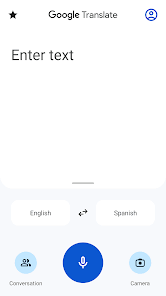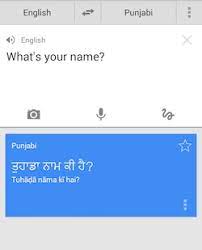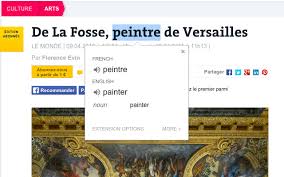Google Translate: Breaking Language Barriers and Connecting the World
In today’s interconnected world, communication plays a crucial role in bridging cultures, fostering understanding, and enabling collaboration. However, language barriers often pose significant challenges to effective communication. This is where Google Translate comes to the rescue.
Google Translate is a powerful online translation service developed by Google. With its user-friendly interface and extensive language support, it has become an essential tool for millions of people worldwide. Whether you are a traveler exploring new destinations, a student studying foreign languages, or a business professional communicating with international partners, Google Translate has revolutionized the way we overcome language differences.
One of the standout features of Google Translate is its vast language coverage. With support for over 100 languages, including major global languages like English, Spanish, French, German, Chinese, and Arabic, as well as lesser-known languages and dialects, Google Translate truly caters to a diverse range of users.
The technology behind Google Translate is based on cutting-edge machine learning algorithms and artificial intelligence. It continuously learns from vast amounts of multilingual data to improve translation accuracy and naturalness over time. This means that as more people use Google Translate and contribute to its usage data, the translations become increasingly refined and reliable.
The versatility of Google Translate extends beyond simple text translation. It also offers features like voice input/output for spoken translations and image translation using your smartphone’s camera. These additional functionalities make it even more convenient for users to get real-time translations on the go.
While Google Translate provides an invaluable service to individuals seeking quick translations for personal use, it also offers great benefits to businesses operating in global markets. With the ability to translate websites, documents, emails, and other business communications instantly, companies can expand their reach and effectively communicate with customers from different linguistic backgrounds.
However, it’s important to note that while Google Translate is an incredible tool that has made significant advancements in machine translation technology, it is not without limitations. Translations may occasionally be inaccurate or lack the nuances of human interpretation. Therefore, it’s always advisable to use Google Translate as a helpful aid rather than solely relying on it for critical or sensitive translations.
In conclusion, Google Translate has revolutionized the way we communicate and connect with people from different cultures and languages. It breaks down language barriers and opens up endless possibilities for collaboration, learning, and understanding. As technology continues to evolve, we can expect Google Translate to become even more sophisticated and accurate, further enhancing our ability to communicate effortlessly in a multilingual world.
6 Essential Tips for Using Google Translate
- Use the “Detect language” feature to quickly identify the source language of your text.
- Use simple, direct language for best results when translating from one language to another.
- Always double-check translated text for accuracy and clarity before using it in a professional setting or sharing with others.
- Use Google Translate’s “Speak” feature to hear translations spoken aloud in multiple languages.
- Take advantage of Google Translate’s “Phrasebook” feature to save commonly used phrases and access them quickly later on.
- Utilize Google Translate’s “Transcribe” feature to transcribe speech into written words in over 60 languages and dialects
Use the “Detect language” feature to quickly identify the source language of your text.
Google Translate Tip: Utilize the “Detect Language” Feature for Quick Source Language Identification
When using Google Translate, one of the most helpful features that often goes unnoticed is the “Detect language” option. This handy tool allows you to quickly identify the source language of any text you want to translate, even if you’re unsure of its origin.
The “Detect language” feature comes in especially handy when you come across a piece of text or receive a message in an unfamiliar language. Instead of manually selecting the source language from a long list, simply click on the “Detect language” option and let Google Translate do the work for you.
To use this feature, open Google Translate and enter or paste your text into the input box. Next to the “From” section, there is a drop-down menu where you can select the source language. Right below that menu, you’ll find a small button labeled “Detect language.” Clicking on it triggers Google Translate’s powerful algorithms to analyze your text and determine its original language.
This time-saving feature is particularly beneficial when dealing with multilingual texts or when encountering languages with similar scripts or unfamiliar writing systems. Instead of guessing or making assumptions about the source language, rely on Google Translate’s accurate detection capabilities to ensure precise translations.
The “Detect language” option also proves useful when working with documents containing multiple languages. By using this feature, you can easily identify and translate each section in its respective language without manually selecting them one by one.
Whether you’re a student studying foreign languages, a traveler navigating different cultures, or someone communicating with international contacts, taking advantage of the “Detect language” feature in Google Translate can significantly streamline your translation process and save valuable time.
So next time you encounter an unknown text or need assistance determining the source language accurately, remember to utilize this convenient feature in Google Translate. With just a click, you’ll be able to swiftly identify the original language and proceed with confidence, ensuring accurate translations and effective communication across linguistic boundaries.
Use simple, direct language for best results when translating from one language to another.
When it comes to using Google Translate effectively, one valuable tip to keep in mind is to use simple and direct language for the best translation results. While the technology behind Google Translate has made impressive advancements, it still works best with straightforward and uncomplicated sentences.
Using simple language helps ensure that the translation is accurate and clear, minimizing the risk of misinterpretation or confusion. Complex sentence structures, idiomatic expressions, or technical jargon can sometimes pose challenges for machine translation systems like Google Translate.
By using concise and straightforward language, you provide Google Translate with the best chance of accurately conveying your intended meaning. This approach is particularly helpful when translating from one language to another, as it allows the system to focus on capturing the essence of your message rather than getting caught up in intricate linguistic details.
Remember that Google Translate is a tool that assists in bridging language barriers, but it may not always capture the full nuances or cultural context of a text. Therefore, keeping your translations simple and direct can help facilitate clearer communication while using this powerful tool.
In summary, when utilizing Google Translate for translations between languages, employing simple and direct language is key to achieving more accurate results. By doing so, you enhance your chances of conveying your intended message effectively while minimizing potential errors or misunderstandings.
Always double-check translated text for accuracy and clarity before using it in a professional setting or sharing with others.
The Importance of Double-Checking Translated Text with Google Translate
Google Translate has undoubtedly become an indispensable tool for quick and convenient translations. Its advanced algorithms and extensive language support make it a go-to resource for millions of users worldwide. However, when it comes to using translated text in a professional setting or sharing it with others, it is crucial to exercise caution and double-check for accuracy and clarity.
While Google Translate has made significant advancements in machine translation technology, it is not infallible. Like any automated translation system, it may occasionally produce inaccurate or misleading results. This is especially true for complex sentences, idiomatic expressions, cultural nuances, or technical jargon that may require human understanding to convey the intended meaning accurately.
To ensure that the translated text is reliable and suitable for professional use, taking the time to double-check its accuracy is essential. Here are a few steps you can follow:
- Compare translations: If you have a basic understanding of the source language, compare the original text with its translated version. Look out for any significant discrepancies or errors that might alter the intended message.
- Contextualize the translation: Consider the broader context in which the translated text will be used. Ensure that it aligns appropriately with your intended purpose and audience expectations.
- Seek native speaker assistance: If possible, consult a native speaker or language expert who can review the translation for accuracy and clarity. Their expertise can help identify any potential issues that might have been overlooked.
- Proofread carefully: Even if you are confident in the translation’s accuracy, proofreading is always beneficial. Check for grammatical errors, spelling mistakes, or awkward phrasing that could affect comprehension.
By following these steps and being diligent in double-checking translated text before using it professionally or sharing it with others, you can avoid misunderstandings or miscommunications that may arise from inaccurate translations.
Remember, while Google Translate is an excellent tool for getting the gist of a text or understanding basic information, it should not be solely relied upon when precise and nuanced translations are required. Human translators or language professionals are better equipped to handle complex or sensitive content that demands accuracy and fluency.
In conclusion, while Google Translate is a valuable resource for quick translations, it is essential to exercise caution and double-check translated text before using it in professional settings or sharing it with others. By taking these extra steps, you can ensure accuracy, clarity, and effective communication across languages.
Use Google Translate’s “Speak” feature to hear translations spoken aloud in multiple languages.
Enhance Your Language Learning with Google Translate’s “Speak” Feature
Have you ever wondered how a specific word or phrase sounds in another language? Or perhaps you’re learning a new language and want to practice your pronunciation. Look no further than Google Translate’s “Speak” feature, which allows you to hear translations spoken aloud in multiple languages.
Whether you’re a language enthusiast, a traveler, or a student, this nifty feature can be incredibly helpful. Not only does it provide an opportunity to listen to accurate pronunciations, but it also helps you develop an ear for different languages and improve your own speaking skills.
Using the “Speak” feature is simple. Just type or paste the text you want to translate into Google Translate, select the desired language for translation, and click on the speaker icon next to the translated text. Google Translate will then pronounce the translation for you, allowing you to hear how it should sound.
This feature is not limited to single words or short phrases; it can handle longer sentences and paragraphs as well. Whether you want to understand how a famous quote sounds in another language or need assistance with understanding an entire passage, this feature has got you covered.
The ability to hear translations spoken aloud can be particularly useful when learning languages with complex pronunciation rules or unfamiliar sounds. It helps familiarize your ears with these nuances and improves your overall comprehension of the language.
Additionally, Google Translate’s “Speak” feature is available for numerous languages across the globe. From widely spoken languages like English, Spanish, French, and Mandarin Chinese to lesser-known ones like Swahili or Icelandic, this tool offers an extensive range of options for learners and curious minds alike.
Remember that while Google Translate’s “Speak” feature provides accurate pronunciations most of the time, there may be occasional variations depending on accents and dialects within a specific language. Therefore, it’s always beneficial to consult native speakers or language resources for further guidance and refinement.
So, whether you’re exploring a new language, perfecting your pronunciation, or simply satisfying your curiosity about how words sound in different languages, Google Translate’s “Speak” feature is a valuable tool to have at your fingertips. Embrace the opportunity to listen and learn, and let the world of languages unfold before your ears.
Take advantage of Google Translate’s “Phrasebook” feature to save commonly used phrases and access them quickly later on.
Google Translate’s “Phrasebook” Feature: Your Language Companion
Have you ever found yourself repeatedly searching for the translation of a particular phrase or sentence? Whether it’s a common greeting, a useful expression, or a specific question, Google Translate offers a nifty solution with its “Phrasebook” feature.
The “Phrasebook” feature is designed to make your translation experience even more convenient and efficient. It allows you to save commonly used phrases and access them quickly later on, eliminating the need to search for them repeatedly. This can be especially helpful if you find yourself using certain phrases frequently or if you’re learning a new language and want to build up your vocabulary.
To utilize this feature, simply translate the desired phrase using Google Translate. Once the translation appears, you will see a small bookmark icon alongside it. By clicking on this icon, the phrase will be saved to your personal Phrasebook within Google Translate.
The beauty of this feature lies in its accessibility. Whether you’re using Google Translate on your computer or mobile device, your saved phrases will be synchronized across all platforms. This means that no matter where you are or which device you’re using, you can easily access your Phrasebook and retrieve those important phrases with just a few taps or clicks.
Not only does the Phrasebook feature save time by eliminating repetitive searches, but it also helps in language learning and cultural immersion. By building up your collection of frequently used phrases, you can enhance your fluency and confidence when communicating in another language. It serves as a personalized language companion that is always at your fingertips.
Moreover, Google Translate allows you to organize and categorize your saved phrases within the Phrasebook itself. You can create different folders based on topics such as greetings, travel essentials, dining out, or any other categories that suit your needs. This way, finding the right phrase becomes even easier as your Phrasebook grows.
So next time you come across a useful phrase that you want to remember, take advantage of Google Translate’s “Phrasebook” feature. Save it once, and access it whenever you need it. Whether you’re a frequent traveler, a language enthusiast, or simply someone who wants to communicate effectively across languages, this feature is sure to become your go-to tool.
With Google Translate’s “Phrasebook” feature, language barriers become less daunting, and communication becomes more accessible. So go ahead and start building your personalized Phrasebook today – your language companion awaits!
Utilize Google Translate’s “Transcribe” feature to transcribe speech into written words in over 60 languages and dialects
Google Translate’s “Transcribe” Feature: Transforming Spoken Words into Written Text
In a world where communication is key, Google Translate has emerged as a game-changer, breaking down language barriers and enabling seamless communication across borders. Among its many powerful features, one that stands out is the “Transcribe” feature, which allows users to transcribe speech into written words in over 60 languages and dialects.
The Transcribe feature takes advantage of advanced speech recognition technology to convert spoken words into text in real-time. Whether you’re attending a lecture in a foreign language, conducting an interview with someone who speaks a different language, or simply need assistance in understanding spoken content, this feature can be incredibly useful.
To utilize the Transcribe feature, all you need to do is open the Google Translate app on your smartphone or access it through the web interface. Select the desired source and target languages, and then tap on the microphone icon to start transcribing. As you speak or listen to someone speaking in the source language, Google Translate will instantly convert their words into written text in the target language.
This feature not only helps individuals understand spoken content but also serves as a valuable tool for language learners. By transcribing spoken words into written text, learners can follow along more easily and reinforce their understanding of vocabulary and grammar.
Moreover, businesses operating globally can leverage this feature for various purposes. For instance, during meetings or conferences with international participants, using Transcribe can ensure accurate documentation of discussions for future reference. It also facilitates effective communication between team members who speak different languages.
It’s important to note that while Google Translate’s Transcribe feature is highly efficient and convenient, it may encounter occasional challenges with complex sentences or accents. However, continual advancements in speech recognition technology are being made to enhance accuracy and overcome such limitations.
In conclusion, Google Translate’s Transcribe feature empowers users by transforming spoken words into written text across more than 60 languages and dialects. Whether you’re a language learner, a traveler in need of instant translation, or a business professional seeking effective communication solutions, this feature is a valuable asset. Embrace the power of technology and let Google Translate assist you in breaking down language barriers and fostering global understanding.




